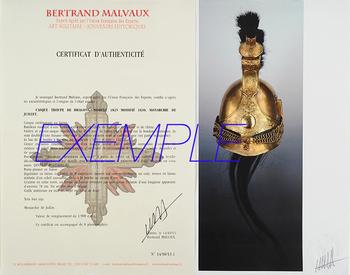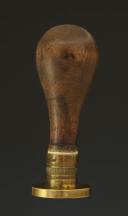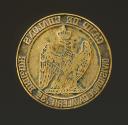
CACHET À ENCRE « CAMP DE CHALONS DIVISION DE CAVALERIE 2e BRIGADE » Second Empire. 23915
Sold out
INK STAMP "CAMP DE CHALONS CAVALRY DIVISION 2nd BRIGADE" Second Empire. 23915
Round bronze stele representing the imperial eagle, with the inscription “CAMP DE CHALONS DIVISION DE CAVALERIE 2nd BRIGADE”. Black waxed wooden handle.
France.
Second Empire.
Very good state.
HISTORY: The Châlons camp, also known as the Mourmelon camp, is a French military camp located in Mourmelon, near the town of Châlons-en-Champagne (Marne). History Châlons camp by Gustave Le Gray in 1857. Created by the will of Napoleon III and inaugurated on August 30, 1857, the Châlons camp was of great importance during the Second Empire. It constitutes an area of 10,000 hectares which have been purchased from 1,300 owners. The oldest mentions were the Champs Catalauniques, which were located in local memory as being in Châlons and the oppidum of La Cheppe is called camp d'Attila. There were already previous camps, one in 1792 and another in 1841; they were closer to the city and saw themselves named: Fagnière camp, Mont Saint-Michel camp, Haut-Chaillot camp, but especially Châlons camp. The engineer captain Pierre Weynand who built and maintained the camp spent his entire career up to the rank of general within the framework of the camp. The land there was uncultivated or of little value, the railway not too far away and the flat ground, which favored the establishment of this labor camp in the region. Napoleon III signed the imperial decree and the camp was sometimes called "telegraph camp", "camp Napoleon" or "camp imperial". The layout: two pyramids mark the boundaries of the camp. One dates from August 18, 1861, the other from August 15, 1867. The report to the prefect specifies "at the end of the Châlons camp... I had a simple pyramid built there... ". It is 6.83 m at a place called Grand-Moré on a 50 m roundabout dating from 1860, as part of the improvements to local roads. The inscriptions: on the column: • Roman road restored in 1861 (camp side) • Imperial district 5 km away (west side) • Local road of common interest no. 32 (Reims side) • Reims 23 km away and Bar-le- Duc at 76 km (east side) on the foot: • the rural communes that have been neglected for so long must have a large share in state subsidies, because the improvement of the countryside is even more useful than the transformation of the cities. Extract from the Emperor's letter. (side of the camp) • 1856 creation of the camp of Châlons (west side) • it is especially necessary to pursue with vigor the completion of the local roads. This is the greatest service to be rendered to agriculture (on the Reims side) • old Roman road from Durocorturum (Reims) to Divodurum (Metz) via Caturigis (Bar-le-Duc) Caturigis at XXXIII Gallic leagues Durocorturum at X Gallic leagues (East Coast). The new pyramid on local road 21 going from the Veuve to Mourmelon would be 800 m from the headquarters; it was paid for by subscription from the municipalities of the Marne and by the General Council, sculpture by Gustave Moriamé like the previous monument, three steps, in Euville stone, it culminates at 12 m in height. Inauguration by General Leboeuf who commanded the camp of Châlons, Bourgeois member of the General Council, Champois mayor of Mourmelon-le-Grand, Rouyer mayor of Bouy, Crochet mayor of Louvercy, on August 14th. A railway line from Châlons to Mourmelon-le-Petit was created to serve the camp, its commissioning took place on October 14, 1857. Strasbourg and leads to the Mourmelon-le-Petit station provided for the embarkation and disembarkation necessary for the military. The water supply was a recurring problem even if the Cheneu was the main source, after having considered an aqueduct from the Vesle and noted that the low water level of the stream, a hundred wells were dug but very little masonry and drinking troughs mobiles were used for the animals. A library which was abounded by donations from personalities of the Second Empire, it was looted in 1870. Farms, initially they had to provide food for men and animals and had to grow cereals and vegetables. The breeding part came very quickly to be put into practice. A model of land development, a place for experimenting with grafting and acclimatization, they were also used to recycle the waste produced on site. They were eight in number on 1,200 hectares, in addition to the imperial farm there were some in Bouy, Cuperly, de Jonchery, Mont-Piémont, Suippes and Saint-Hilaire as well as in Vadenay, Monsieur de Saucourt was the first director of the imperial farms. Le Moniteur of October 30, 1862 praised the production of the Châlons camp: 16,276 tons of wool, 121,710 liters of milk, 121,900 tons of rye, 84,177 tons of oats, 49,058 tons of wheat and 75 tons of meat. These farms also employed local civilian labor.
Round bronze stele representing the imperial eagle, with the inscription “CAMP DE CHALONS DIVISION DE CAVALERIE 2nd BRIGADE”. Black waxed wooden handle.
France.
Second Empire.
Very good state.
HISTORY: The Châlons camp, also known as the Mourmelon camp, is a French military camp located in Mourmelon, near the town of Châlons-en-Champagne (Marne). History Châlons camp by Gustave Le Gray in 1857. Created by the will of Napoleon III and inaugurated on August 30, 1857, the Châlons camp was of great importance during the Second Empire. It constitutes an area of 10,000 hectares which have been purchased from 1,300 owners. The oldest mentions were the Champs Catalauniques, which were located in local memory as being in Châlons and the oppidum of La Cheppe is called camp d'Attila. There were already previous camps, one in 1792 and another in 1841; they were closer to the city and saw themselves named: Fagnière camp, Mont Saint-Michel camp, Haut-Chaillot camp, but especially Châlons camp. The engineer captain Pierre Weynand who built and maintained the camp spent his entire career up to the rank of general within the framework of the camp. The land there was uncultivated or of little value, the railway not too far away and the flat ground, which favored the establishment of this labor camp in the region. Napoleon III signed the imperial decree and the camp was sometimes called "telegraph camp", "camp Napoleon" or "camp imperial". The layout: two pyramids mark the boundaries of the camp. One dates from August 18, 1861, the other from August 15, 1867. The report to the prefect specifies "at the end of the Châlons camp... I had a simple pyramid built there... ". It is 6.83 m at a place called Grand-Moré on a 50 m roundabout dating from 1860, as part of the improvements to local roads. The inscriptions: on the column: • Roman road restored in 1861 (camp side) • Imperial district 5 km away (west side) • Local road of common interest no. 32 (Reims side) • Reims 23 km away and Bar-le- Duc at 76 km (east side) on the foot: • the rural communes that have been neglected for so long must have a large share in state subsidies, because the improvement of the countryside is even more useful than the transformation of the cities. Extract from the Emperor's letter. (side of the camp) • 1856 creation of the camp of Châlons (west side) • it is especially necessary to pursue with vigor the completion of the local roads. This is the greatest service to be rendered to agriculture (on the Reims side) • old Roman road from Durocorturum (Reims) to Divodurum (Metz) via Caturigis (Bar-le-Duc) Caturigis at XXXIII Gallic leagues Durocorturum at X Gallic leagues (East Coast). The new pyramid on local road 21 going from the Veuve to Mourmelon would be 800 m from the headquarters; it was paid for by subscription from the municipalities of the Marne and by the General Council, sculpture by Gustave Moriamé like the previous monument, three steps, in Euville stone, it culminates at 12 m in height. Inauguration by General Leboeuf who commanded the camp of Châlons, Bourgeois member of the General Council, Champois mayor of Mourmelon-le-Grand, Rouyer mayor of Bouy, Crochet mayor of Louvercy, on August 14th. A railway line from Châlons to Mourmelon-le-Petit was created to serve the camp, its commissioning took place on October 14, 1857. Strasbourg and leads to the Mourmelon-le-Petit station provided for the embarkation and disembarkation necessary for the military. The water supply was a recurring problem even if the Cheneu was the main source, after having considered an aqueduct from the Vesle and noted that the low water level of the stream, a hundred wells were dug but very little masonry and drinking troughs mobiles were used for the animals. A library which was abounded by donations from personalities of the Second Empire, it was looted in 1870. Farms, initially they had to provide food for men and animals and had to grow cereals and vegetables. The breeding part came very quickly to be put into practice. A model of land development, a place for experimenting with grafting and acclimatization, they were also used to recycle the waste produced on site. They were eight in number on 1,200 hectares, in addition to the imperial farm there were some in Bouy, Cuperly, de Jonchery, Mont-Piémont, Suippes and Saint-Hilaire as well as in Vadenay, Monsieur de Saucourt was the first director of the imperial farms. Le Moniteur of October 30, 1862 praised the production of the Châlons camp: 16,276 tons of wool, 121,710 liters of milk, 121,900 tons of rye, 84,177 tons of oats, 49,058 tons of wheat and 75 tons of meat. These farms also employed local civilian labor.
Reference :
23915

Next update Friday, april 4th at 1:30 PM
FOR ALL PURCHASES, PAYMENT IN MULTIPLE CHECKS POSSIBLE
bertrand.malvaux@wanadoo.fr 06 07 75 74 63
An authenticity certificate of the item including the description published on the site, the period, the sale price, accompanied by one or more color photographs is automatically provided for any item priced over 130 euros. Below this price, each certificate is charged 5 euros.
Only items sold by me are subject to an authenticity certificate, I do not provide any expert reports for items sold by third parties (colleagues or collectors).


